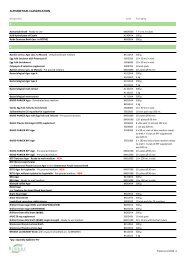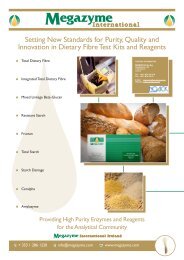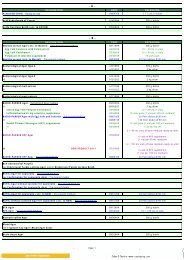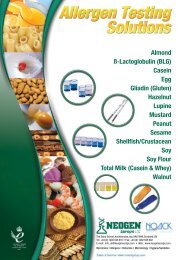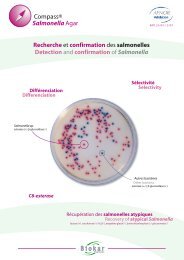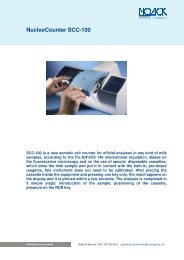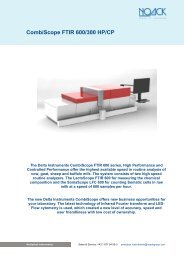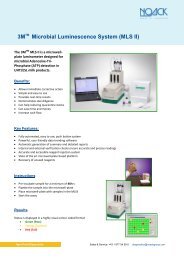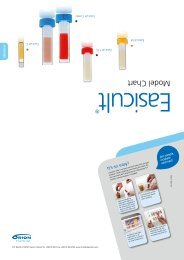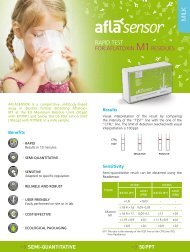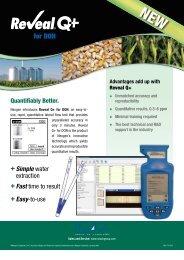Petrifilm Environmental Listeria Interpretation Guide - NOACK
Petrifilm Environmental Listeria Interpretation Guide - NOACK
Petrifilm Environmental Listeria Interpretation Guide - NOACK
- No tags were found...
Create successful ePaper yourself
Turn your PDF publications into a flip-book with our unique Google optimized e-Paper software.
3M <strong>Petrifilm</strong> <strong>Interpretation</strong> <strong>Guide</strong>3M <strong>Petrifilm</strong> <strong>Environmental</strong> <strong>Listeria</strong> PlatesThis guide familiarizes you with results on 3M <strong>Petrifilm</strong> <strong>Environmental</strong> <strong>Listeria</strong> Plates. For more information, contact the 3M Microbiologyrepresentative nearest you.The <strong>Petrifilm</strong> environmental <strong>Listeria</strong> (EL) plate is a sample-ready culture medium containing selective agents, nutrients, a cold-watersoluble gelling agent and a chromogenic indicator that facilitates <strong>Listeria</strong> colony detection. <strong>Petrifilm</strong> EL plates are designed to analyse environmentalsamples and to help increase the efficiency of monitoring plant sanitation. The presence of indicator <strong>Listeria</strong> such as <strong>Listeria</strong>innocua provides evidence that environmental conditions are suitable for the occurrence of <strong>Listeria</strong> monocytogenes. The <strong>Petrifilm</strong> EL platedetects the majority of environmental <strong>Listeria</strong>, consisting of <strong>Listeria</strong> monocytogenes, <strong>Listeria</strong> innocua, and <strong>Listeria</strong> welshimeri.*Many organisms in the environment can be stressed by environmental conditions or sanitizers. Buffered peptone water (BPW) is used as arepair broth in conjunction with the <strong>Petrifilm</strong> EL plate to resuscitate stressed <strong>Listeria</strong> without increasing their numbers. Repair in BPW is notan enrichment step.1.1.This <strong>Petrifilm</strong> EL plate has NO colonies after 28h of incubation.The test is complete.Quantitative <strong>Interpretation</strong>: <strong>Listeria</strong> colonies on this plate:
QuantitativeSampling & <strong>Interpretation</strong>If your facility chooses to use the <strong>Petrifilm</strong> environmental <strong>Listeria</strong> plate in a quantitative manner, please refer to the product packageinsert, and then calculate the colony forming units (CFU) per area as shown below. You may also want to consider the following points:• Consistency is the key to obtaining useful information from your environmental monitoring programme. Use a consistent procedure each time that you sample.Ideally, use the same type of sampling device and techniques.• The sampling area size may be based on regulations, internal standards and/or the location of the monitoring. For example, you may need to sample a largerarea for a finished goods area because the numbers of bacteria are expected to be low.• More information on environmental sampling can be found in the references listed below and in the <strong>Petrifilm</strong> plates environmental monitoring proceduresbrochure.TO DETERMINE the quantity of <strong>Listeria</strong> per sampled area, you will need to record:1) area size sampled2) volume of hydration fluid in the sampling device3) volume of the buffered peptone water added4) volume plated5) number of colonies countedAPPLY the following equation or worksheet to determine the CFU/area sampled. Examples are given on the following pages.See Package Insert & Reminders for Use for full details of the method.You may also determine the result per sample, e.g., CFU/ drain.CFU/area = (Number of colonies x [mL hydration fluid + mL BPW] ÷ 3 mL) ÷ area sampledorA. Total number of mL of BPW + hydration fluid:B. Number of mL plated:C. Divide line A by line B:D. Number of colonies counted:(if number of colonies is zero, insert “
Quantitative <strong>Interpretation</strong>Example: Swab Contact Method31 2 water (see line A).Using a swab (or equivalent) moistenedwith 1 mL of hydration fluid(see line A), sample an area. For thisexample, area is fifty square centimeters(50 cm 2 ) (see line F). Returnswab to sterile container.Add 2 mL of buffered peptoneAfter repair step, plate 3 mLonto the <strong>Petrifilm</strong> environmental3<strong>Listeria</strong> plate (see line B).After incubation, count colonies.4 For this example, assume youcount fifty (50) colonies (seeline D).A. Total number of mL of BPW + hydration fluid:B. Number of mL plated:C. Divide line A by line B:D. Number of colonies counted:E. Multiply line C by line D:F. Area sampled:G. Divide line E by line F:1 + 2 = 3A3B1C50D50E50 cm 2F1 CFU/cm 2 GExample: Sponge Contact Method3Using a sponge moistened with 101 mL of hydration fluid, sample anarea (see line A). For this example,area is fifty square centimeters(50 cm 2 ) (see line F).Return the sponge to the sterile2 container and add 5 mL of bufferedpeptone water (see line A).After repair step, plate 3 mL ontothe <strong>Petrifilm</strong> environmental <strong>Listeria</strong>3plate (see line B).After incubation, count colonies.4 For this example, assume youcount ten (10) colonies (seeline D).A. Total number of mL of BPW + hydration fluid:B. Number of mL plated:C. Divide line A by line B:D. Number of colonies counted:E. Multiply line C by line D:F. Area sampled:G. Divide line E by line F:10 + 5 = 15A3B5C10D50E50 cm 2F1 CFU/cm 2 G
Additional Comments3M Microbiology offers a full range of <strong>Petrifilm</strong> count plates designed to meet microbial testing requirements withinthe Food Industry.For further product information please visit our website:www.3M.com/microbiology3M Deutschland GmbH3M MicrobiologyCarl-Schurz-Straße 141453 NeussGermanyPhone +49 (0) 2131/14 4350Fax +49 (0) 2131/14 4397Internet www.3m.com/microbiologyPlease recycle. Printed in Germany.© 3M 2008. All rights reserved.1389-101-EU3M and <strong>Petrifilm</strong> are trademarks of the3M company.



